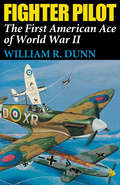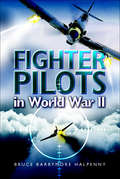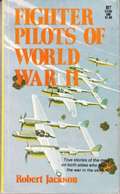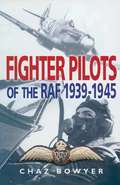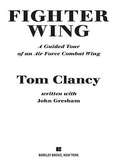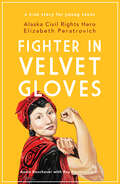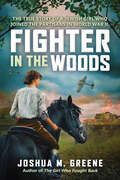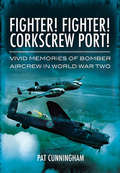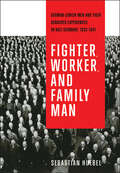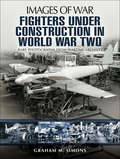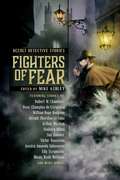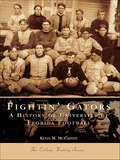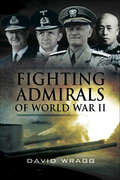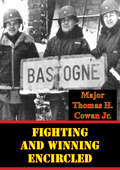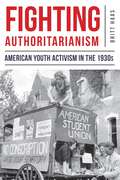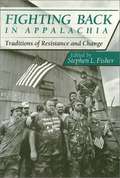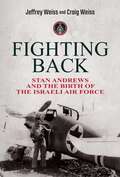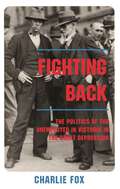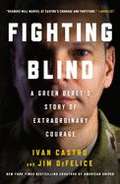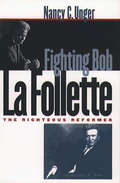- Table View
- List View
Fighter Pilot: The First American Ace of World War II
by William R. DunnThis WWII fighter pilot memoir recounts the author&’s many exploits as a flying ace during WWII in the Normandy invasions, the Battle for France and beyond. Born in Minneapolis in 1916, William R. Dunn decided to become a fighter pilot at the age of twelve. In 1939 he joined the Canadian Army and was soon transferred to the Royal Air Force. As part of the RAF&’s famous Eagle Squadron, Dunn was sent to Europe to fight in the Second World War. Flying Hawker Hurricanes and Supermarine Spitfires, he was the first Eagle Squadron pilot to shoot down an enemy aircraft. When he later transferred to the US Army Air Forces, he became the first American ace of the war. Lieutenant Colonel Dunn saw action in the Normandy invasion and in Patton's sweep across France. Twenty years later he fought again in Vietnam. In this lively memoir, Dunn keenly conveys the fighter pilot's experience of war—the tension of combat, the love of aircraft, the elation of victory, the boisterous comradeship and competition of the pilot brotherhood.
Fighter Pilot: The Memoirs of Legendary Ace Robin Olds
by Robin Olds Christina Olds Ed RasimusThe biography of American fighter pilot Robin Olds, who was a larger-than-life hero with a towering personality.
Fighter Pilots in World War II: True Stories of Frontline Air Combat
by Bruce Barrymore HalpennyThis is the story of Allied fighter pilots and the part they played in all the principal operational theatres of World War II. It also tells of life on the wartime airfield and how ground crew kept the aircraft ready for action either in the bitter cold of a Scottish winter or the sweltering heat of the North African desert. The book brings home the nervous strain caused by the constant readiness demanded by all those involved with fighter squadron combat and the intense comradeship created in each fighting unit.
Fighter Pilots of World War II
by Robert JacksonTo select fourteen fighter pilots from the hundreds who fought with distinction on all sides during World War II has been a difficult, not to say impertinent task. In the end, as representative of all the others, I selected those who, to my mind, showed certain individual characteristics that seemed to set them apart.
Fighter Pilots of the RAF, 1939–1945
by Chaz BowyerThe author has selected some twenty RAF fighter pilots of the Second World War, not only to give overdue recognition to their prowess and courage, but also to exemplify the wide diversity of the individual characters of those men whose war was fought from the cockpit of an RAF fighter. A few were familiar names but most received little or no public acclaim, being part of the silent majority which provided the real spine of the RAF's fighter effort throughout the conflict.
Fighter Wing: A Guided Tour of an Air Force Combat Wing (Tom Clancy's Military Referenc #3)
by Tom Clancy John GreshamNow, for the first time, an insider's look at an Air Force combat wing --the planes, the technology, and the people . . . with Tom Clancy as your guide. UPDATED WITH NEW MATERIALS AND PHOTOS!
Fighter in Velvet Gloves: Alaska Civil Rights Hero Elizabeth Peratrovich
by Annie Boochever Roy Peratrovich, Jr.“No Natives or Dogs Allowed,” blared the storefront sign at Elizabeth Peratrovich, then a young Alaska Native Tlingit. The sting of those words would stay with her all her life. Years later, after becoming a seasoned fighter for equality, she would deliver her own powerful message: one that helped change Alaska and the nation forever. In 1945, Peratrovich stood before the Alaska Territorial Legislative Session and gave a powerful speech about her childhood and her experiences being treated as a second-class citizen. Her heartfelt testimony led to the passing of the landmark Alaska Anti-Discrimination Act, America’s first civil rights legislation. Today, Alaska celebrates Elizabeth Peratrovich Day every February 16, and she will be honored on the gold one-dollar coin in 2020. Annie Boochever worked with Elizabeth’s eldest son, Roy Peratrovich Jr., to bring Elizabeth’s story to life in the first book written for young teens on this remarkable Alaska Native woman.
Fighter in the Woods: The True Story of a Jewish Girl who Joined the Partisans in World War II
by Joshua M. GreeneFrom award-winning author Joshua M. Greene (The Girl Who Fought Back; Signs of Survival) comes this remarkable true story of a Jewish girl in Nazi-occupied Poland who escaped near death to join -- and fight -- with the Soviet partisans in the woods. Scholastic Focus is the premier home of thoroughly researched, beautifully written, and thoughtfully designed works of narrative nonfiction aimed at middle-grade and young adult readers. These books help readers learn about the world in which they live and develop their critical thinking skills so that they may become dynamic citizens who are able to analyze and understand our past, participate in essential discussions about our present, and work to grow and build our future.The year was 1941, and Nazi Germany was bombing Poland. Celia Kassow, a young Jewish girl, knew she was in danger of being seized by the Nazis, so she ran to seek shelter at a Polish classmate's house. The classmate's response? "Get away from here, you dirty Jew."Celia and her family, like all the Jewish families in their town, were then imprisoned in a Nazi ghetto, facing daily starvation and torture. Most of Celia's family was murdered there, but a different Polish classmate of Celia's, a boy who had a crush on her, helped Celia escape to his family's farm, and eventually, into the woods to join the Soviet partisans.The partisans were resistance fighters who gathered in secret during WWII to fight back against the Axis powers by attacking German garrisons and blowing up trains. When Celia joined them, the other partisans -- mostly young men -- wanted to put her on kitchen duty, but Celia refused and asked to be put on patrol. She was given a horse, ammunition, and an assignment. Celia survived the war fighting with the partisans. After the war, she would go on to get married, have children, and immigrate to the United States, where she lived out her days assisting other immigrants and raising her family. Her true story, based on first-person testimony and vetted by Celia's son, is one of incredible bravery and grit in the face of unimaginable evil.
Fighter! Fighter! Corkscrew Port!: Vivid Memories of Bomber Aircrew in World War Two
by Pat CunninghamThe young men who flew with RAF Bomber Command in World War Two were a complex mixture of individuals but they all shared the gift of teamwork. A crew of seven may have comprised all non-commissioned men and some crews included commissioned officers but not always flying as pilots. The outstanding fact was that each man relied on every other member of his crew to return from each mission safely.This book contains ten intriguing reminiscences of bomber aircrew; some were pilots, others navigators, flight engineers, bomb-aimers or gunners. They flew as both commissioned or NCO airmen. Understandably, a common problem was that of coping with fear. Many former aircrew hold that anyone who claims to have felt no fear on operations is either lying or has allowed the years to blank out that fear. But there are a few who do maintain that they never felt afraid. For the majority, though, handling fear was something to be worked out by the individual. Some hit the bottle, others womanized to excess; others tightened the gut and bit the lip; or drew the curtain and focused upon the plotting table or the wireless set. The passing years may have silvered what hair remains, dulled the eye that formerly registered on the merest speck; lent a quiver to the hand that once controlled the stick, penciled in the track, manipulated the tuning dial, set the bombsight, tapped the gauge, or rotated the turret. And yet for all the attributes of age their irrepressible youthfulness shines through.
Fighter's Alley (Bareknuckle)
by Heather Duffy StoneWill's father is running for mayor. The competition is slim. So all Will has to do is keep from embarrassing his family during the election. Problem is, Will has been secretly boxing down at the Woodrat Club—just the sort of seedy place Will's dad wants to stomp out. After training with Eddie Tancredi, a mysterious ex-boxer, Will enters a high-stakes Woodrat tournament. He even has a shot at victory. But will his family conflict ruin his chances? If not, secrets from Eddie’s past might . . .
Fighter, Worker, and Family Man: German-Jewish Men and Their Gendered Experiences in Nazi Germany, 1933–1941 (German and European Studies)
by Sebastian HuebelWhen the Nazis came to power, they used various strategies to expel German Jews from social, cultural, and economic life. Fighter, Worker, and Family Man focuses on the gendered experiences and discrimination that German-Jewish men faced between 1933 and 1941. Sebastian Huebel argues that Jewish men’s gender identities, intersecting with categories of ethnicity, race, class, and age, underwent a profound process of marginalization that destabilized accustomed ways of performing masculinity. At the same time, in their attempts to sustain their conceptions of masculinity these men maintained agency and developed coping strategies that prevented their full-scale emasculation. Huebel draws on a rich archive of diaries, letters, and autobiographies to interpret the experiences of these men, focusing on their roles as soldiers and protectors, professionals and breadwinners, and parents and husbands. Fighter, Worker, and Family Man sheds light on how the Nazis sought to emasculate Jewish men through propaganda, the law, and violence, and how in turn German-Jewish men were able to defy emasculation and adapt – at least temporarily – to their marginalized status as men.
Fighters Over the Fleet: Naval Air Defence from Biplanes to the Cold War
by Norman FriedmanA tactical and technical history of the development of British, American, and Japanese naval air defense from the 1920s to the 1980s. This is an account of the evolution of naval fighters for fleet air defense and the parallel evolution of the ships operating and controlling them, concentrating on the three main exponents of carrier warfare: the British Royal Navy, the U.S. Navy, and the Imperial Japanese Navy. It describes the earliest efforts from the 1920s, but it was not until radar allowed the direction of fighters that organized air defense became possible. Thus, major naval-air battles of the Second World War like Midway, the Pedestal convoy, the Philippine Sea, and Okinawa are portrayed as tests of the new technology. This was ultimately found wanting by the Kamikaze campaigns, leading to postwar moves towards computer control and new kinds of fighters. After 1945 the threats of nuclear weapons and standoff missiles compounded the difficulties of naval air defense. The second half of the book covers R.N. and U.S.N. attempts to solve these problems, looking at the American experience in Vietnam and British operations in the Falklands War. It concludes with the ultimate U.S. development of techniques and technology to fight the Outer Air Battle in the 1980s, which in turn point to the current state of carrier fighters and the supporting technology. Based largely on documentary sources, some previously unused, this book will appeal to both the naval and aviation communities.&“Fighters Over the Fleet provides more information about fleet air defense than any other work currently available. It is recommended for specialist as well aviation-minded readers.&” —Naval Historical Foundation
Fighters Under Construction in World War Two: Rare Photographs From Wartime Archives (Images of War)
by Graham M. SimonsThere has been bookshelf after bookshelf of books compiled, written and published about British aircraft, the Royal Air Force and the activities of its pilots during World War Two. Tales of derring do, bravery and gallantry quite rightly litter the bookshelves and libraries, but little has appeared in print about the could be called the unsung heroes, those that designed, built and maintained the fighting equipment used to eventually defeat the enemy.This is all the more incredible when one realizes that there exists a huge archive of images that have survived which clearly show the skills and scale of what went on. These images of war—many of which are seen here for almost the first time in seventy years—form a remarkable tribute to the designers, engineers and workers who did so much.Following the end of the Great War, the Royal Air Force was drastically reduced in both manpower and equipment. The application of a 'Ten Year Rule in which the British Government foresaw no war being fought during the next ten years resulted in minimal defense expenditure throughout the 1920s.Financial restrictions went on until the early 1930s, when it at last became apparent that Germany was developing expansionist and aggressive tendencies that could no longer be ignored. The British Government and Air Ministry at last began to develop plans of their own to expand and develop the Royal Air Force. The Cabinet approved a number of plans, but a revised one often replaced each one before the original could be completed.Between 1933 and 1939, the Royal Air Force was given higher priority in terms of rearmament plans than the other services. The policy was driven by the pursuit of parity with Germany more than by defense and strike needs, for there was no fixed ratio of bombers to fighter aircraft to guide procurement.There could be no expansion without manufacturing capacity and luckily these manufacturers were not only capable of producing, but they also recorded much of their activities and remarkably a huge archive of images have survived which clearly show the skills and scale of what went on. These images of war—many of which are seen here for almost the first time in seventy years—form a remarkable tribute to the designers, engineers and workers who did so much.
Fighters in the Shadows: A New History of the French Resistance
by Robert GildeaRobert Gildea's penetrating history of France during World War II sweeps aside the French Resistance of a thousand clichés. Gaining a true understanding of the Resistance means recognizing how its image has been carefully curated through a combination of French politics and pride, ever since jubilant crowds celebrated Paris's liberation in 1944.
Fighters of Fear: Occult Detective Stories
by Mike AshleyA Retrospective Collection of Classic Occult and Supernatural Detective Stories by Some of the Field&’s Greatest and Best-Known Weird Fiction Authors Since the gaslit nights at the end of the nineteenth century, the occult detective has been a beloved and recurring archetype. Mixing the best aspects of the detective tale and weird or supernatural fiction, and capitalizing in part on the massive popularity of Sherlock Holmes, these stories portrayed men and women pitted against surreal and horrifying foes, usually with little to defend them but their own savvy, experience, and know-how. From William Hope Hodgson&’s Thomas Carnacki, to Seabury Quinn&’s fearless Frenchman Jules de Grandin, to Jessica Salmonson&’s Penelope Pettiweather, the occult detective has taken a variety of forms, investigated a wide array of supernatural and otherworldly cases, and entertained generations of readers. This new collection compiles thirty-one all-time classic occult detective stories as it traces the genre&’s growth from its nineteenth-century origins to the late twentieth century, showcasing the work of acclaimed pioneers of weird tales alongside cult favorites and exciting modern talents. So, step into the shadows, join us on this journey into the dark, and become a fighter of fear . . .CONTENTS Introduction, Mike Ashley Green Tea, Joseph Sheridan Le Fanu The Shining Pyramid, Arthur Machen The Haunted Child, Arabella Kenealy The Mystery of the Felwyn Tunnel, L. T. Meade & Robert Eustace The Story of Yand Manor House, E. & H. Heron The Tapping on the Wainscott, Allan Upward Samaris, Robert W. Chambers The Whistling Room, William Hope Hodgson The Woman with the Crooked Nose, Victor Rousseau The Sorcerer of Arjuzanx, Max Rittenberg The Ivory Statue, Sax Rohmer The Stranger, Claude & Alice Askew The Swaying Vision, Jessie Douglas Kerruish The Sanatorium, F. Tennyson Jesse The Villa on the Borderive Road, Rose Champion de Crespigny The Room of Fear, Ella Scrymsour The Seven Fires, Philippa Forest The Subletting of the Mansion, Dion Fortune The Jest of Warburg Tantavul, Seabury Quinn The Soldier, A. M. Burrage The Horror of the Height, Sydney Horler The Mystery of Iniquity, L. Adams Beck The Thought-Monster, Amelia Reynold Long The Shut Room, Henry S. Whitehead Dr. Muncing, Exorcist, Gordon MacCreagh The Case of the Haunted Cathedral, Margery Lawrence The Shonokins, Manly Wade Wellman The Dead of Winter Apparition, Joseph Payne Brennan The Garden of Paris, Eric Williams St. Michael and All Angels, Mark Valentine Jeremiah, Jessica Amanda Salmonson
Fightin' Gators: A History of the University of Florida Football (Campus History)
by Kevin M. McCarthyExperience the University of Florida football program's fascinating 20th century journey, one that has brought enjoyment to millions and national recognition to the school.The University of Florida, the state's oldest and largest university, is recognized today as one of the country's most academically diverse public institutions. Though able to trace its history to 1853, the school did not begin its popular football program until the first few years of the 20th century. The program has had its share of scandals and embarrassments over time, but it has also produced two Heisman Trophy winners, a national champion, numerous players drafted into the professional ranks, and a visibility that consistently ranks the team in the top five in the country. Now attracting 85,000 fans to each of its home games, the Gators' football program has become a vital part of the University of Florida. When the team won the national championship in 1996, no one could have predicted such success just 90 years earlier. Fortunately, that journey through the last century has been captured in great photographs that include formal portraits of teams, action shots on the field, views of the stadium simply referred to as "The Swamp" by fans, and snapshots from every decade. These images tell the story of the birth and growth of a football team.
Fighting Admirals of World War II
by David WraggSeapower was a crucial element in the outcome of the Second World War. The U-Boat campaign almost brought Britain to her knees; the Arctic convoys were crucial to keeping Russia in the War; Pearl Harbor brought America into the conflict with massive repercussions; allied naval supremacy made the D-Day landings possible.This book examines in detail the key naval commanders of both sides including five British (Pound, Cunningham, Ramsay, Horton, Somerville) and five US admirals (King, Nimitz, Spruance, Halsey, Fletcher), three German (Raeder, Doenitz, Lutjens) three Japanese (Yamamato, Nagumo, Koga) and two French (Darlan, de la Borde), the latterjustified by the problems faced by Vichy France, including the courageous decision to scuttle the fleet rather than let it fall into German hands in late 1942. In selecting the list, the author has made their decisive role in the war the only criterion.
Fighting And Winning Encircled
by Major Thomas H. Cowan Jr.This monograph answers the question "What must an encircled unit be provided and do in order to successfully hold?" Following the end of the Cold War and the subsequent drawdown, the United States adopted a military strategy of force projection. Given this new strategy, any future adversary of the United States is likely to attack early to deny the points of entry into the theater. The initial deploying U.S. forces must be prepared to fight and defend these points of entry until relieved or reinforced.The author uses historical examples of encirclements from World War II, Korea, and Vietnam to support lessons learned during a major simulation exercise in which a division had to fight encircled. The report presents the preconditions that an operational commander must set for the encircled unit which are: provide the necessary combat power, apply external pressure on the enemy, maintain air superiority, provide logistical support, and give the tactical commander freedom of action. Then the report takes a systems perspective to analyze the tactical commander's mission using the battlefield operating systems as a tool. The author presents the specific tasks the commander must execute and the concepts that he must consider. If the operational commander does not provide the necessary preconditions for success or the tactical commander does not take a systems perspective when setting up the defense, the encircled unit will fail.
Fighting Authoritarianism: American Youth Activism in the 1930s
by Britt HaasDuring the Great Depression, young radicals centered in New York City developed a vision of and for America, molded by their understanding of recent historical events, in particular the Great War and the global economic collapse, as well as by the events unfolding both at home and abroad. They worked to make their vision of a free, equal, democratic society based on peaceful coexistence a reality. Their attempts were ultimately unsuccessful but their voices were heard on a number of important issues, including free speech, racial justice, and peace. A major contribution to the historiography of the era of the Great Depression, Fighting Authoritarianism provides a new and important examination of U.S. youth activism of the 1930s, including the limits of the New Deal and how youth activists continually pushed FDR, Eleanor Roosevelt, and other New Dealers to do more to address economic distress, more inclusionary politics, and social inequality. In this study, author Britt Haas questions the interventionist versus isolationist paradigm in that young people sought to focus on both domestic and international affairs. Haas also explores the era not as a precursor to WWII, but as a moment of hope when the prospect of institutionalizing progress in freedom, equality, and democracy seemed possible.Fighting Authoritarianism corrects misconceptions about these young activists’ vision for their country, heavily influenced by the American Dream they had been brought up to revere: they wanted a truly free, truly democratic, and truly equal society. That meant embracing radical ideologies, especially socialism and communism, which were widely discussed, debated, and promoted on New York City college campuses. They believed that in embracing these ideologies, they were not turning their backs on American values. Instead, they believed that such ideologies were the only way to make America live up to its promises. This study also outlines the careers of Molly Yard, Joseph Lash, and James Wechsler, how they retracted (and for Yard and Lash, reclaimed) their radical past, and how New York continued to hold a prominent platform in their careers. Lash and Wechsler both worked for the New York Post, the latter as editor until 1980. Examining the Depression decade from the perspective of young activists highlights the promise of America as young people understood it: a historic moment when anything seemed possible.
Fighting Back in Appalachia: Traditions of Resistance and Change
by Stephen L. FisherEssays explore various forms of resistance in Appalachia including community organizing and labor unions.
Fighting Back: Stan Andrews and the Birth of the Israeli Air Force
by Jeffrey Weiss Craig WeissFighting Back is the story of Stan Andrews, an assimilated American Jew and World War II veteran who became one of the first fighter pilots in the history of the Israeli Air Force.In 1948, Stan Andrews left a comfortable postwar life in Los Angeles to travel to the war-torn Middle East, where a four-front Arab invasion threatened to destroy the newly-declared State of Israel. There he joined the Israeli Air Force and became one of its first fighter pilots. Andrews was an unexpected volunteer for the fight for a Jewish state. He was many things—an artist, writer, assimilated Jew, ladies&’ man, pilot, and combat veteran of the Pacific War. He had previously been aloof from the struggle for Jewish independence but found himself so roused by the anti-Semitism of 1940s America that he decided to go to Israel and risk everything. Stan made the most of his time in Israel, serving in fighter and bomber squadrons and leaving his mark on an Israeli Air Force that has since become the stuff of legend.
Fighting Back: The Politics of the Unemployed in Victoria in the Great Depression
by Charlie FoxWork for the Dole is not a new idea. It was introduced in Victoria in 1932 and became one of the battlegrounds of unemployed politics. The provision and administration of sustenance, relief work, eviction of tenants from their homes, the issue of free speech—these were the major issues confronting unemployed workers and their families and organisations, and they fought successive governments over each one. Written in a pleasingly clear and accessible style, this absorbing work shows how complex unemployed politics was, and situates it in the long history of agitation by unemployed workers. It takes issue with the prevailing historical orthodoxy that unemployed workers in Australia during the Great Depression were introspective, politically apathetic and concerned only with survival. It shows that, to the contrary, they were active, organised and remarkably successful in their aims. It also shows that government unemployment relief was as much a product of this agitation as it was of government policies and preferences. Yet the movement was always pulled in other direction; by the hunger and poverty of its members, by their need simply to survive, by the disengagement that accompanies individual powerlessness and by resignation in the face of such an incomprehensible disaster. That a creative, often extensive and vigorous unemployed movement could exist in such circumstances, in a decade of the worst poverty Australia has known, is surely a tribute to the courage and resistance of the men and women who made unemployed politics. Fox's book takes a complex look at the actual politics of the unemployed in the Great Depression, a subject which, for various reasons. Hence it represents a substantial revision of the existing historiography.
Fighting Blind: A Green Beret's Story Of Extraordinary Courage
by Jim DeFelice Ivan Castro Ivan Castro and Jim DeFeliceFighting was a practiced routine for Lieutenant Ivan Castro. But when a mortar round struck the rooftop of his sniper’s post in Iraq, he found himself in a battle more difficult than even he could have imagined. The direct hit killed two other soldiers and nearly claimed Castro’s life as well. Mangled by shrapnel and badly burned, Castro was medevac’d to Germany more dead than alive. His lungs were collapsed. He couldn’t hear. One eye had been blown out, the nerve to the other severed. In the weeks and months that followed, Castro would find that physical darkness was nothing compared to the emotional darkness of loss and despair. Desperate for a reason to live, he eventually fought his way back to health through exercise and a single-minded goal: running a marathon. Once he set his course, there was no stopping him. Stubborn to a point that at times bordered on insanity, he managed not only to recover but to return to active duty. Since 2007, he has run over two dozen marathons, including the Boston Marathon in 2013, where he was one of the runners diverted when the bombs exploded. Today, Castro helps prepare soldiers for combat, working exactly as if he were “sighted.” Fighting Blind, this frankly told account of his struggle through adversity, the highs and lows and the always bumpy road in between, is a story of hope and perseverance against the odds: an Unbroken for the present generation.
Fighting Bob La Follette
by Nancy C. UngerRobert "Fighting Bob" La Follette (1855-1925) was one of the most significant leaders of American progressivism. Nancy Unger integrates previously unknown details from La Follette's personal life with important events from his storied political career, revealing a complex man who was a compelling mixture of failure and accomplishment, tragedy and triumph.Serving as U.S. representative from 1885 to 1891, governor of Wisconsin from 1901 to 1906, and senator from Wisconsin from 1906 to his death in 1925, La Follette earned the nickname "Fighting Bob" through his uncompromising efforts to reform both politics and society, especially by championing the rights of the poor, workers, women, and minorities.Based on La Follette family letters, diaries, and other papers, this biography covers the personal events that shaped the public man. In particular, Unger explores La Follette's relationship with his remarkable wife, feminist Belle Case La Follette, and with his sons, both of whom succeeded him in politics. The La Follette who emerges from this retelling is an imperfect yet appealing man who deserves to be remembered as one of the United States' most devoted and effective politicians.
Fighting Brigadier: The Life of Brigadier James Hill DSO** MC
by Peter HarclerodeIn the 1930s James Hill was forced to leave the Army because he was under 26 when he married. Recalled to the colors, he won his MC with the BEF in 1940. He was one of the first to volunteer for airborne forces and became second-in-command of 1 PARA. He was in the thick of the expansion of Airborne forces in 1941-42 and took command of 1 PARA in North Africa, winning his first DSO. He converted 10th Bn The Essex Regiment to 9 PARA and later in 1943 took command of 3 Parachute Brigade, playing a major role in the D-Day Landings. Wounded twice, his Brigade captured the key Merville Battery.The Brigade recovered to England in September 1944 before returning to Europe to contain the German winter Bulge offensive. In March 1945 his Brigade played a key role in the Rhine Crossing and raced east to block the Russian advance on Denmark.Post war Brigadier Hill was a leading figure in the Parachute Regiment and revered by fellow Paras. He died in 2006.
